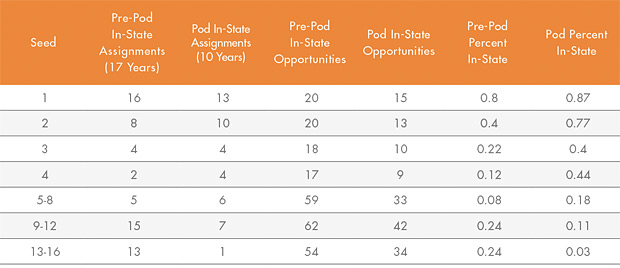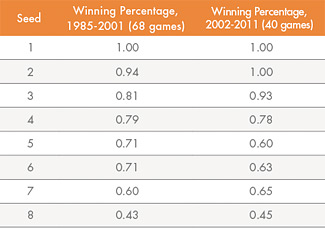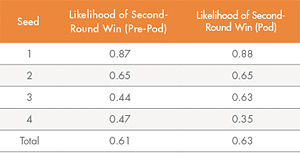Since the implementation of the pod system in 2002 gave the NCAA Division I Men’s Basketball Tournament Selection Committee a greater opportunity to keep teams closer to home for first- and second-round tournament games 1 we analyzed the committee’s assignments over the last 27 tournaments to understand the impact of such seeding on the tournament performance of affected teams. Below, we share findings of our analysis of opening-round assignments and games before and after the use of the pod system.
First, we find that since the pod system was implemented, the tournament selection committee has preferred to place only teams seeded in the top four of a region into an opening-round assignment in the team’s home state. Related to the first finding, we find that, second, since the pod system was implemented, the opening-round winning percentage of top four seeds has increased from 88.6% to 92.5%, and the likelihood of a top four seed reaching the third round has increased from 60.7% to 62.5%. Our evidence allows for us to conclude that the NCAA is signaling that it wants to assign favorable first- and second-round assignments largely to the top 16 teams in the tournament.
To determine how the selection committee’s assignment choices have evolved since the advent of the pod system, we counted, by seed, the number of in-state, opening-round assignments that were given and could have been given, in the 17 pre-pod system tournaments that took place between 1985 and 2001 and the 10 most recent tournaments. (For example, if Greensboro, NC, hosted a first-round game and the team from the University of North Carolina was assigned a first-round game in Greensboro, then we counted that as both an opportunity to make an in-state assignment and the filling of an in-state assignment.)
In table 1, we report these counts, along with the percentage of in-state assignments filled. Note that during the pod system era, the selection committee has become much more likely to place a team seeded second through fourth in a region into an in-state, opening round assignment. For instance, in the tournaments that preceded the pod system, second seeds received eight out of a possible 20 in-state, opening-round assignments (40%). Since 2002, second seeds have played instate, opening-round games on 10 out of 13 possible occasions (77%). Teams seeded lower than fourth often have become less likely to receive an in-state assignment in the pod system era. This trend is especially true for teams seeded 13th and lower, as these teams received 13 of 54 (24%) possible in-state assignments in the pre-pod system and only one of 34 (3%) possible instate, opening-round assignments since 2002.
Granting an in-state assignment is not the only way the selection committee can reward a team; it can also assign a team to play close to campus. Given the committee’s habit of awarding high seeds in-state assignments since it implemented the pod system, it is not surprising that top seeds have been playing closer to home since 2001 [table 2].
Table 1 – Top Seeds Have Been Receiving Better Assignments in Pod System Era

Table 2 — Travel Distances of Top Seeds Have Fallen Since Pod System Implemented

Between 1985 and 2001, the top four seeds in each region had to travel an average of 712 miles to reach their first-round sites, which is 257 miles further than the four highest-seeded teams have had to travel since the pod system was implemented. On the other hand, in the pod system era, the top four seeds’ opponents, seeded between 13 and 16, are being made to travel 63 more miles on average. In the pod system era, teams seeded between five and eight have been traveling about 130 more miles to their first-round games, while the ninth through 12th seeds have had to travel 79 fewer miles to their opening-round games.
In the decade since the pod system was implemented, top teams have flourished in the first round [table 3]. In the pod system era, the first-round winning percentages of the top four seeds–—the teams that have been most likely to receive an in-state assignment in the pod era–—have increased or remained roughly the same. This trend is especially true of third-seeded teams, which have won 93% of their opening-round games since 2002, which is 12 percentage points larger compared to the pre-pod era. Of course, first- and second-round games are played at the same site, so an in-state, first-round assignment could translate into an in-state, second-round game.
Since highly seeded teams have become more likely to win first-round games and receive favorable first-round assignments, we compared the likelihood that top four seeds would win their second-round games and play in the third round, before and after the pod system was implemented [table 4].
Note, prior to the pod system, number-one seeds reached the third-round 87% of the time. Since the pod system was implemented, top seeds have played in the third round 88% of the time. Among the top four seeds, third seeds have become significantly more likely to see thirdround action, while, in what might be explained by the increased parity of the tournament, fourth seeds have become much more likely to be eliminated before the third round of the tournament. (The fourth seeds have become more likely to be beaten by fifth seeds, since the pod system was implemented.) Nonetheless, even in an era in which lower seeds like George Mason, Butler, and Virginia Commonwealth have made the national semifinals (and beyond), the top four seeds have become more likely to play into the second week of the tournament since the pod system was implemented.
Table 3 — First-Round Winning Percentages of Top Eight Seeds

Table 4 — Top Seeds Have Become More Likely to Reach the Third Round Since 2002

To conclude, the implementation of the pod system in 2002 gave the NCAA Division I Men’s Basketball Tournament Selection Committee a greater opportunity to keep teams closer to home for first- and secondround tournament games. Our analysis of the committee’s assignments over the last 27 tournaments shows that, since the pod system was implemented, teams seeded second through fourth in a region have been much more likely to receive an in-state, first-round assignment from the selection committee and are required to travel significantly fewer miles for the first weekend of the tournament. Since the pod system’s creation, the second and third regional seeds have become more likely to win their first- and second-round games and advance to the second weekend of the tournament, despite increased parity among tournament teams (as evidenced by lower-seeded teams such as Butler, George Mason, and Virginia Commonwealth advancing to the Final Four). The more favorable treatment of second through fourth seeds in the pod system era means that these seed assignments are more valuable than they were in earlier tournaments. We find that teams seeded in these positions face lower travel times and costs and receive greater fan support in the first weekend of play, which seems to have increased the success rate of second- and third-seeded teams during the first weekend of the tournament.
We are proud to feature submissions from academia and college athletics professionals to promote best practices. We give special thanks to Todd McFall, PhD and Stephen G. Bronars, PhD for this article. The findings in this article are inspired by and based upon a paper entitled “The NCAA Basketball Tournament Selects Fan Favorites over Parity” that Drs. McFall and Bronars presented during the Hooponomics section at the Southern Economic Association 2011 Program.
 Dr. McFall is a visiting assistant professor who teaches in the Economics Department at Wake Forest University. He earned a PhD in 2005 from North Carolina State University, where he received a department-level award for his dissertation and a university-level award for his teaching. Dr. McFall’s research includes the economics of sports.
Dr. McFall is a visiting assistant professor who teaches in the Economics Department at Wake Forest University. He earned a PhD in 2005 from North Carolina State University, where he received a department-level award for his dissertation and a university-level award for his teaching. Dr. McFall’s research includes the economics of sports.
 Dr. Bronars is a senior economist in the Washington, DC, office of Welch Consulting . Dr. Bronars received his PhD in economics from the University of Chicago. Before joining Welch Consulting, he was the Leroy Denman Jr. Regents Professor and Chairman of the Economics Department at the University of Texas at Austin. He has held faculty positions at the University of California, Santa Barbara, Texas A&M University, Yale University, and the WhartonSchool, and is currently an adjunct professor at Georgetown University.
Dr. Bronars is a senior economist in the Washington, DC, office of Welch Consulting . Dr. Bronars received his PhD in economics from the University of Chicago. Before joining Welch Consulting, he was the Leroy Denman Jr. Regents Professor and Chairman of the Economics Department at the University of Texas at Austin. He has held faculty positions at the University of California, Santa Barbara, Texas A&M University, Yale University, and the WhartonSchool, and is currently an adjunct professor at Georgetown University.
Key Insights
Since the implementation of the pod system in 2002, the top four seeds in each region have had to travel fewer miles to their first-round games and are more likely to draw in-state assignments. During that same period, the winning percentages of teams seeded in the top four have either improved or remained roughly the same.
References:
- Every March the NCAA Division I Men’s Basketball Tournament Selection Committee chooses its tournament field, and while doing so, it must abide by certain self-imposed rules. For instance, it tries to avoid the possibility of an intra-conference match-up before the third-round, and it will not place a participant into a contest on the team’s home court. However, since 2002, the selection committee has been freed from the mandate that required all eight teams assigned to an arena site in the tournament’s opening round to be from the same 16-team region. For the past 10 tournaments, the committee has used the “pod system,” which has allowed it to assign teams from two different regional fields to the same first-round arena site. By relaxing the constraint that all eight teams at a first-round site must be from the same region, the NCAA has increased its ability to place participating tournament teams close to their homes for the opening round of the tournament. ↩




